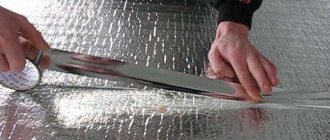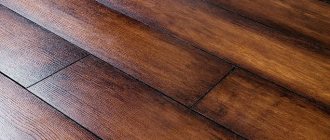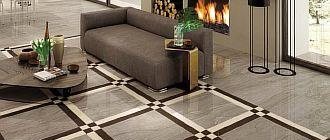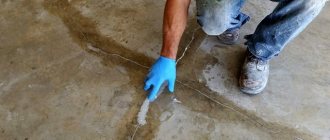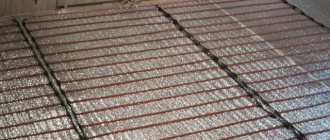Many owners of apartments and private houses are wondering whether it is possible to lay laminate flooring on a heated floor. This flooring has a lot of advantages and an attractive appearance, so questions often arise regarding this material. Not all types of laminate are suitable for achieving this goal. It is necessary to choose a coating that can withstand elevated temperatures and other aggressive factors.
Compatibility between laminate and heated floors can be achieved with a competent approach to the selection of materials. It is important not only to choose a suitable floor covering, but also to take care of the correct choice of fastening agents. Not all compositions are able to withstand consistently high temperatures, so it is worth thoroughly preparing before construction purchases.
Classification of installation options for laminate flooring with heated floors
To answer the question of whether it is possible to lay laminate flooring on a heated floor, you need to understand its classification. The following schemes are widely used today:
- film;
- electrical;
- aquatic.
When installing the floor covering, you can use any option from the list presented - there are no fundamental differences between them. If you follow the rules for connecting to the heating system, no problems arise. It is also necessary to take into account the requirements presented by the material manufacturer.
A few important notes
Even the highest quality laminate will require a special approach when installing it on a “warm floor”.
- The screed over the heating elements must gain full strength
In the case of concrete mortar, the curing period is at least four weeks, and have a moisture content of no more than 1.5% (concrete) or 0.3% (anhydrite compositions).
The floor must be dried and heated throughout its entire thickness.
To do this, no less than 2 weeks before installation, turn on the heating system and, adding no more than 5 degrees per day, bring it to 50% of the design power, and then, within 2 days, to full.
Then the system is turned off and installation begins after it has completely cooled, but the temperature should not be lower than 15 degrees.
- After installation is completed, the system is put into operation in the same stepwise manner.
Practice shows that to achieve the optimal floor surface temperature of 22-25 degrees, you will need to set the operating temperature of the coolant (heating cable) to 40-50 degrees.
The exact value will need to be determined experimentally and strictly adhered to during operation so as not to cause overheating and deformation of the surface.
The same actions, but in reverse order, are carried out at the end of the heating period.
Sudden temperature changes are detrimental to laminate flooring.
To prevent the formation of condensation, a polyethylene film approximately 0.2 mm thick must be laid between the screed and the substrate.
Film type heated floors
This option is ideal for installing heated floors. Film floors have the following advantages:
- easy temperature adjustment;
- optimal thickness;
- no need for screeds.
The laminate is heated directly from the very contact with the working platform. A thin layer of backing ensures uniform heat distribution over the entire area. This option is economical to operate. The finished floor quickly reaches the required temperature and maintains it, providing comfort and coziness.
Working with a water floor
In this case, it is necessary to strictly observe the thickness of the screed that covers the heating pipe systems. This surface should not exceed 6 centimeters. You should not make a screed that is too thick, as it warms up slowly and quickly loses the required temperature.
You should not use a thin surface, which can warm up very quickly, creating discomfort and inconvenience during operation. In this case, there will be a high risk of cracks and chips on the surface of the laminate, as a result of which you will have to do all the work again. To ensure uniform heat distribution, it is necessary to install a screed of optimal thickness - from 30 to 60 millimeters.
Heated laminate is not recommended for use when connected to central heating. In this case, the work itself can be very expensive due to the need to install equipment to regulate the coolant. Otherwise, you risk quickly deteriorating the coating and incurring unnecessary costs. When using an autonomous heating system, laminate can be freely used subject to all rules and requirements from the material manufacturer.
Foundation installation on concrete
The installation of the floor surface begins with cleaning and inspecting the screed to identify irregularities and cracks. If defects are detected, a thin leveling screed, 2 to 4 cm thick, is poured. Next, waterproofing is performed: bitumen-roofing felt, or using polymer films.
Then extruded polystyrene foam insulation (EPS) 3-4 cm thick is laid. A reinforcing mesh is mounted on the EPS layer to secure the coolant pipes, or they are fastened with staples to the expanded polystyrene.
Working with screed when installing electric heated floors
Installing an electrical cable also requires a screed. To avoid excessive energy consumption, you should not make a coating whose thickness exceeds 30 millimeters. A mandatory rule is the presence of a temperature control and regulation system. Otherwise, the surface may become cracked.
For any option for installing a heated floor, the screed must meet the following characteristics:
- high density;
- absence of voids;
- high quality materials;
- completely flat surface.
To obtain the desired result, plasticized additives or special mixtures are used to create a dense, reliable and durable screed.
A well-equipped surface takes quite a long time to warm up, but serves as an excellent storage mechanism that provides stable energy savings.
Pitfalls when installing heated floors with laminate
The main problem in this area is that woodworking technology is still far from perfect. It is difficult to find products on the market that can easily withstand high temperatures without the use of auxiliary products.
Many laminate manufacturers use substances that contain formaldehyde. As the temperature rises, these toxic compounds are released and create a high level of danger indoors. Fortunately, construction technologies make it possible to get rid of this limitation by installing a reliable screed.
The temperature of the heated floor for laminate should not exceed 22 degrees. You should not increase this indicator to 30 to avoid the occurrence of dangerous fumes. It is also worth monitoring the humidity level. At 50%, you need to purchase a special humidifier to normalize the indicators.
The question of whether a heated floor under a laminate is harmful can be answered ambiguously. If you follow a certain construction technology, any risks can be reduced to zero.
Which underlay to choose for laminate?
It is recommended to lay laminate on a substrate. The substrate should conduct heat well, be 1.5-3 mm thick and have an average density, such as a special substrate with perforation.
Main functions of the substrate:
- The backing eliminates knocking and creaking noises that occur when walking.
- Makes the floor warmer. The substrate has a heat-conducting function; when purchasing a substrate, you need to take into account its characteristics so that the heat does not escape under the floor. The total TRC (thermal resistance coefficient) consists of the laminate and substrate coefficient indicators, it should be no more than 0.15 m2 K/W
- When laying laminate plates, the underlay levels the surface of the floor, as it is able to compress and stretch in the right places. It absorbs external pressure, taking into account that the laminate plates may move slightly at the attachment points.
- Using 3 mm polyethylene, you can reduce the echo of the laminate from 15 to 17 dB, using felt and polystyrene - by 20 dB.
- The substrate provides moisture insulation using a special film made of polyvinyl chloride, polyisobutylene or polyethylene with a thickness of 200 microns. In modern models, these materials are included in the structure of the laminate; sometimes they are purchased separately.
Types of substrate
The following types of substrates are suitable for residential premises:
- Polyethylene (cheap, used if the floor is flat).
- Expanded polystyrene (with high thermal insulation, moisture resistance, immunity to temperature fluctuations and mechanical stress).
- Cork (does not mold, does not wrinkle, retains heat well and absorbs noise). However, they are expensive and can leak moisture if you do not put plastic film under it.
- Bitumen-cork and combined substrates, consisting of several materials, have good characteristics, but there is a drawback - a fire hazard, therefore they are rarely used in residential buildings.
Important note! Do not confuse underlayment for water heated floors and underlayment for laminate flooring. Remember that the substrate is not a proper insulator.
What to consider when choosing building materials?
Not all laminate models are suitable for installing heated floors. The first thing you need to pay attention to is the labeling of the product. You can find models on the market that are designed specifically for these purposes. Choose products that have one of the following labels on their packaging:
- "Underflоorheating";
- "H2O";
- "Warm Wasser".
Materials with such designations are able to withstand any load and be used in particularly extreme conditions. Before carrying out the actual installation, make sure that you have prepared the necessary materials and tools.
If you have any questions or need advice, call us at the phone number listed on the website.
Properties and technical characteristics of the laminate
90% of lamella consists of wood products, and therefore belongs to the class of wooden floor coverings. Laminate coating is sensitive to high humidity, changes in moisture and temperature. At first glance, it may seem that these properties of the laminate already define it as an unsuitable material for laying on a warm floor. This remark is true when we are talking about standard types of laminate. However, specialists have developed special types of this coating that allow it to be used as a flooring for a heated floor.
If you want to lay it on a heated floor, there are increased requirements for the construction of the floor and the quality of the plank. Why? The fact is that if these requirements are neglected, then everything may not turn out in the best way for the owner of the living space.
- In the production of wood-based composite materials, formaldehyde resins are used. Of course, sanitary supervision regulates the level of this substance in the laminate, but it is still impossible to completely get rid of its fumes. At temperatures in the range of 20–22? the coating is harmless, however, when heated to, say, 30 degrees Celsius or more, formaldehyde evaporation increases significantly. The formaldehyde content is indicated on the packaging. It is worth noting that for underfloor heating, a laminate of safety class E1 or E0 is most suitable.
- If you buy a low-quality laminate, then due to the temperature difference that accompanies floor heating, the coating will dry out and become deformed over time. Gaps may appear at the joints, which is why the floor will soon begin to creak. If the relative air humidity in the room in which the laminate flooring and underfloor heating system are installed reaches less than 50%, then to preserve the coating, it makes sense to buy an air humidifier.
- If the principle of installation of underfloor heating and laminate is violated, then due to the difference in temperatures in the floor and room, condensation may accumulate under the laminate, which will damage the coating. And there will be dampness in the room due to rotting of the laminate and the formation of mold underneath it.
The conclusion is obvious: you should not save on laminate flooring, as well as on the craftsmen who will install the heated floor system and floor covering.
Marking features
As is already known, not every type of product is suitable for installation on a heated floor. Next we will talk about which laminate is suitable for laying under heated floors. On the packaging, in addition to the coating class, its compatibility with heated floors must be indicated. These indicators are indicated by special pictograms shown in the photo.
Instead of a pictogram, the packaging may contain the following inscription - Underfloor heating, which literally translates as “Warm floor”. A pictogram with a water formula means that the laminate can be used for installation on a water heated floor system. It should be installed in accordance with the manufacturer's instructions.
Important! The panel thickness must be at least 8 mm. The fact is that a thinner laminate will not withstand constant temperature changes.
The Click connection is suitable for laminate flooring that will be installed on a heated floor. The coating will not come apart, even if small cracks appear on it due to drying out. The modern market offers consumers panels with aluminum locks or with locks that are reinforced with special metal elements.
Laminate can be laid on a heated floor if you purchased panels with a maximum floor heating value, which usually does not exceed 27 degrees Celsius. The indicator that determines the level of resistance is also important. According to some calculations, an underfloor heating system will be justified if the total heating pie does not exceed 0.15 m2K/W. The floor covering, including the substrate, must have a resistance value of 0.10 m2K/W.
What do the E1 and E0 markings mean?
If, when choosing, you find the E1 and E0 markings, then do not be alarmed. This marking indicates the amount of harmful substances contained in its composition, or rather, the amount that is released into the air. It is clear that these harmful substances mean formaldehyde. Its presence is present in almost all laminate models. And it is released when heated. Thus, the E1 marking today is characteristic of almost 99% of various laminated products. In total there are 4 categories:
- E1 per 100 grams of dry matter accounts for up to 10 milligrams.
- E2 per 100 grams of dry matter accounts for 10 to 20 milligrams.
- E3 per 100 grams of dry matter accounts for from 30 to 60 milligrams.
- E0 per 100 grams of dry matter is less than 2.5 milligrams
Laminate class
When choosing a laminate for a heated floor, not only its labeling, but also its class plays an important role. The class directly affects its abrasion. So, the higher the class of the laminate, the better quality it is. And given that laying it on a heated floor creates extreme operating conditions, it is extremely important to approach this issue wisely. Now we will divide the entire living space into zones:
- Bedroom. This may include a children's room, a bedroom for adults, a relaxation room.
- Office and kitchen.
- Entrance hall and corridor.
- Bathroom loggia.
If underfloor heating is installed in these areas, then in each individual case an individual choice of laminate should be made. Let's consider each of the listed zones.
Hallway and bedroom
When laying in a bedroom, nursery or hallway, you can use laminate, whose front side is matte. This coating is antistatic and has a sound-absorbing effect. This coating also copes with moisture. It has a fire-preventing layer on it. It is especially pleasant that the market provides a wide variety of color shades and textures. This will allow you to decorate absolutely any interior where heated floors are installed.
The ideal solution would be laminate class 21 and 22 for heated floors. In this case, a heating cable mat and aluminum plates are used as a heated floor system.
Kitchen
This is a room where many people can be present at the same time. For this reason, there is heavy traffic here. Moreover, the kitchen is characterized by high humidity. There may be a water spill here. For this reason, the chosen laminate for a heated floor in the kitchen must be moisture resistant. It is prohibited to lay laminate flooring without a moisture-repellent layer. In this case, the ideal solution is class 32 and 33 laminate.
Important! With a low thermal conductivity coefficient, this laminate will best harmonize with underfloor heating.
Bathroom and toilet
Often a heated floor system is installed in the bathroom and toilet. Recently, laminate flooring has also been successfully installed in these rooms. In this case, the product must be class 32 or 33. It can easily cope with possible water and high humidity.

